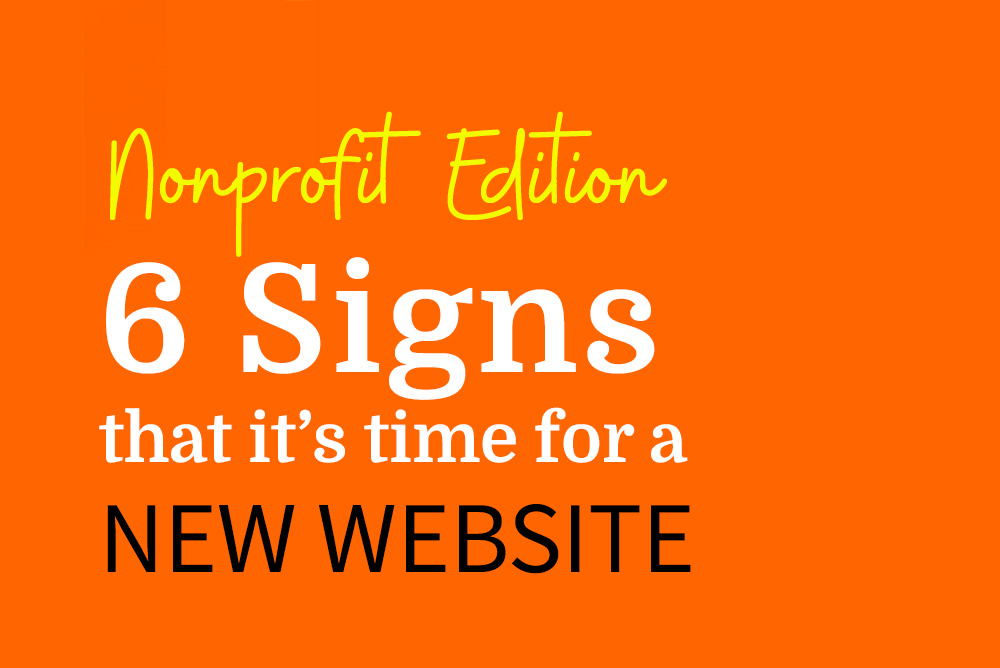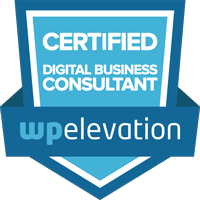Nonprofit Edition: 6 Signs That it’s Time for a New Website
When was the last time you evaluated your website to determine if it was time for your organization to consider a new site?
The lifespan of the average website these days is about two years and seven months according to Orbit Media. Are you pushing that time frame? Three years beyond it? We understand.
We’ve put together the following post to help you determine if it’s time for your nonprofit or foundation to get a new site. (Shameless plug—if that turns out to be the case, no worries, we can help!)

Here are six telltale signs that the time has come for a new website:
1. It’s a pain to update your website, so you avoid it.
Is your organization’s website such a hassle to update that you actively avoid touching it? We’ve worked with more than one organization where the staff created (inefficient and unsustainable) workarounds to avoid the headache of updating the site. Perhaps one of the following situations resonates with you:
You have to call a web developer to make updates (and you dread it).
It would be awesome if you could update your organization’s website yourself instead of depending on a webshop. You’ve found that your webshop is difficult to deal and slow to make changes. You wonder, does this developer understand who the customer is and how customer service works? Doesn’t seem so.
You have to submit a support ticket to make even a simple change, and then it can take days until the change is made. You call to follow up only to feel like you’re an inconvenience. And then there’s the cost…wow, little changes seem to add up.
You have no idea how to update it or it’s a massive production to make updates.
When the site was built, you were told you’d be able to update it easily. Unfortunately, that’s not the reality. It feels like you need to know code just to change a word on the site. Want to add a photo? Forget about it. You don’t even kid yourself about making more significant updates.
You can’t remember the password to login.
It’s been so long since the site has even been updated that no one on staff has the login information. You don’t even know who built the site.

2. The design is so outdated it's embarrassing.
You avoid sending donors to your website. It’s not representative of the important and complex work you do. Instead, it looks amateurish and might very well cause them to wonder if supporting your mission is actually a good idea after all. Why would you intentionally send them there and ding your credibility? Do either of these describe your situation:
The website was built before you took the job.
You inherited this website, including the outdated design. From best you can tell it was an intern project three summers ago. Try as you might, the website is making your job harder. You have modern and updated marketing materials and have perfected your ask, but the design of the website doesn’t match any in-person experience potential donors have with your organization.
It was designed by committee.
Shudder. We all know the results of "design by committee," and yet it still happens to the best of us. Let’s be clear, buy-in from key stakeholders is important. But even a well-meaning committee can get distracted by the details and lose sight of the website's actual audience and core messaging.

3. Your website is being held together by the duct tape of plugins.
Plugins can be great. They can add additional functionality to your website relatively easily. The downside of plugins is that if you've got too many, they can slow down your site speed and they can also conflict with each other. A simple plugin update can result in your website breaking. If you know you've got loads of plugins, at the very least, you should consider whether they are adversely affecting your website's performance and remove the ones that you don't need.

4. Your website is a glorified business card.
If the primary purpose of your website is to provide your contact information, you might want to rethink that strategy.
Whether you design it as such, your website is a valuable relationship building tool. Truthfully, whether you send them there or not, potential donors and other partners are looking you up online. When you treat your website like a business card or even just a brochure, you are missing the chance to share why they should care about your organization. Not to mention inspiring them to donate or support your mission in some other way.

5. You have to direct people on where to find things on your website.
If you have to tell people where to find things on your website, then your website is definitely not doing its job. Content should be easy to find by someone that knows nothing about your organization.
If your office takes regular calls to tell people how to get to certain things on the website, it’s time to take a close look at your sitemap and content. We’ve worked with clients who previously just added more and more items to their homepage and main menu to “improve wayfinding.” The result is overwhelming and cluttered—completely defeating the purpose.
You’ve read this far, so I think we’re friends now, right? Friends don’t let friends turn off visitors and waste administrative resources with these issues.

6. Your website doesn't work on mobile.
Last sign, and it’s a critical one. YOU MUST HAVE A MOBILE-FIRST OR RESPONSIVE WEBSITE. Consider this: in 2018, 52.2% of all website traffic worldwide was generated through mobile phones (Statista). So a prospective donor goes to your site on their phone, and they have to do that weird two-finger zoom in, zoom out on the screen thing. No way. Do you want to make your site difficult to use for the majority of visitors? Since we’re friends now, I know you don’t!
Plus, search engines like Google penalize websites that are not built mobile-first. You don’t want that! Having your site work on mobile is an absolute must.
To wrap this up, your website is an incredibly powerful development and marketing tool. Don’t lose out on relationships and donations by letting your site fall by the wayside. Take action today to start planning improvements on your current site or consider a full website redesign.
If my team and I can help in any way, let us know. Now get back to changing the world (and thank you)!



